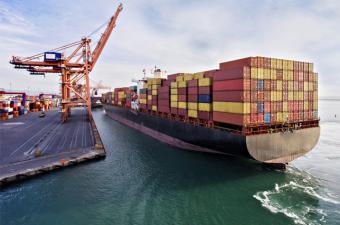
OVERVIEW
The Admiralty Court’s decision in Alize 1954 v Allianz Elementar Versicherungs AG (The CMA CGM LIBRA) [2019] EWHC 481 (Admlty) (8 March 2019) is an interesting modern illustration of the application of well-established principles relating to seaworthiness in the context of the grounding of a large container ship.
The incident
On 17 May 2011, the CMA CGM LIBRA grounded whilst leaving the port of Xiamen, China. Salvage and other general average expenses totalling US$13 million were incurred as a result.
The vessel had been navigated outside the buoyed fairway and ran aground on a shoal in an area where there were charted depths of over 30 metres. The shoal was not marked on the paper Admiralty charts available at the time, but recent Notices to Mariners had warned that numerous depths less than the charted depths existed in the approaches to the port.
The vessel’s passage plan had not provided for the vessel to leave the buoyed fairway. But nor did it contain a clearly marked warning of the danger created by the presence of depths less than those charted.
92% of the Cargo Interests paid their contribution to GA but 8% refused to do so. They submitted that the unsafe and negligently prepared passage plan rendered the vessel unseaworthy and caused the casualty, and as such that they had a defence of actionable fault.
The trial
The Owners’ GA claim was tried before the Admiralty Judge, Teare J, over 6 days in January and February 2019. Several witnesses were cross-examined, including the vessel’s Master and two master mariner expert witnesses called by the parties.
The Owners sought to defend the Master’s navigational decisions as reasonable in the circumstances and also defended the passage plan, maintaining that it was sufficient that the relevant Notice to Mariners was attached or adjacent to the vessel’s working chart.
The Cargo Interests submitted that (1) the vessel was unseaworthy before and at the beginning of the voyage because it carried a defective passage plan; (2) due diligence to make the vessel seaworthy was not exercised by the Owners because the master and second officer failed to exercise reasonable skill and care when preparing the passage plan; and (3) that the defective passage plan was causative of the grounding of the vessel. All of this was disputed by the Owners.
The Court’s decision: navigation, unseaworthiness and causation
The Court reached clear conclusions of fact that the navigation of the vessel had been negligent, that the passage plan was defective and that the defective passage plan was causative of the grounding. The Court found that if there had been a warning on the working chart about charted depths being unreliable, the master would not have attempted the manoeuvre that he did outside the buoyed fairway.
Given the negligent navigation exception in the Hague Rules, however, these conclusions were not of themselves sufficient to give rise to a defence of actionable fault. The court had to be persuaded that the defective passage plan rendered the vessel unseaworthy. In that regard, the Owners had submitted that passage planning is part of navigation and not itself an aspect of seaworthiness.
The Court rejected that submission and held that the vessel was unseaworthy. The long established and authoritative test of unseaworthiness is whether a prudent owner would have required the relevant defect, had he known of it, to be made good before sending his ship to sea; McFadden v Blue Star Line [1905 1 KB 697 at p.706. Applying that test to the facts of the case, Teare J reasoned that:
“Given that, as stated in the IMO Resolution of 1999, a "well planned voyage" is of "essential importance for safety of life at sea, safety of navigation and protection of the marine environment" one would expect that the prudent owner, if he had known that his vessel was about to commence a voyage with a defective passage plan, would have required the defect to be made good before the vessel set out to sea.”
As the Court observed, seaworthiness extends to having on board the appropriate documentation, including the appropriate chart, and a proper passage plan is now, like an up to date and properly corrected chart, a document which is required at the beginning of the voyage.
The Court also rejected an argument by the Owners that, in relation to matters like passage planning, a carrier's duty under Article III r.1 of the Hague Rules was discharged by putting in place proper systems and ensuring that the requisite materials were on board to ensure that the master and navigating officer were able to prepare an adequate passage plan. Teare J observed that the same could be said about chart corrections/ updating, but that if the officer charged with correcting the chart fails to do so in a material respect before the beginning of the voyage, then his failure is capable of rendering the vessel unseaworthy within the McFadden test.
The Court’s decision: due diligence
The Court also rejected a submission on behalf of Owners that due diligence was exercised because their SMS contained appropriate guidance for passage planning and their due diligence obligation did not concern things done by the crew in their capacity as navigators. The actions of the master and second officer in preparing the passage plan were matters of navigation, it was submitted, rather than matters for Owners as carrier.
The Court reviewed the relevant authorities and noted that it has long been recognised that in order to comply with Article III r.1 it is not sufficient that the owner has itself exercised due diligence to make the ship seaworthy. It must be shown that those servants or agents relied upon by the owner to make the ship seaworthy have done so, as the duty is non-delegable. The provision of a proper passage plan is necessary to ensure, so far as reasonably possible, that the vessel will be safely navigated. The master and second office could, by the exercise of reasonable care and skill, have prepared a proper passage plan and as such due diligence was not exercised.
Conclusion
The Court therefore concluded that the Cargo Interests had established causative unseaworthiness and that the Owners had failed to establish the exercise of due diligence to make the vessel seaworthy. That was, as the Court observed, the consequence of applying established propositions of law to the facts of the case: the traditional test of seaworthiness, the principle that proper navigational documentation is an aspect of seaworthiness and the non-delegable nature of the duty to exercise due diligence.
John Russell QC, instructed by Jai Sharma, John Reed, Jessica Cooke at Clyde & Co LLP, acted for the successful Cargo Interests.


